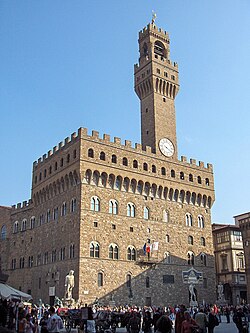Piazza della Signoria
Piazza della Signoria | |
|---|---|
| Public square | |
 | |
| Features | Statues Judith and Holofernes by Donatello and David by Michelangelo, Neptune Fountain |
| Opening date | 1330 |
| Surface | stone |
| Location | Florence, Italy |
| Location of the piazza in Florence | |
| Coordinates: 43°46′11″N 11°15′20″E / 43.76972°N 11.25556°E | |
Piazza della Signoria (Italian pronunciation:
Buildings
The 14th-century
Palazzo Vecchio

The
Originally called the Palazzo della Signoria, after the Signoria of Florence, the ruling body of the Republic of Florence, it was also given several other names: Palazzo del Popolo, Palazzo dei Priori, and Palazzo Ducale, in accordance with the varying use of the palace during its long history. The building acquired its current name when the Medici duke's residence was moved across the Arno to the Palazzo Pitti.
Loggia dei Lanzi


The Loggia dei Lanzi consists of wide arches open to the street, three bays wide and one bay deep. The arches rest on clustered columns with Corinthian capitals. The wide arches appealed so much to the Florentines, that Michelangelo even proposed that they should be continued all around the Piazza della Signoria.[citation needed] The vivacious construction of the Loggia is in stark contrast with the severe architecture of the Palazzo Vecchio. It is effectively an open-air sculpture gallery of antique and Renaissance art including the Medici lions.
Tribunale della Mercanzia
The Tribunale della Mercanzia (Tribunal of Merchandise) is a building where in the past lawyers judged in the trial between merchants. Here was a porch painted by Taddeo Gaddi, Antonio del Pollaiuolo and Sandro Botticelli, today stored in the Uffizi gallery.
Palazzo Uguccioni
Built for Giovanni Uguccioni since 1550, its design has been variously attributed to Raphael, Michelangelo, Bartolomeo Ammannati or Raffaello da Montelupo.
Palazzo delle Assicurazioni Generali
The
Other palaces
Other palaces are the palazzo dei Buonaguisi and the palazzo dell'Arte dei Mercatanti.
Statues


Various imposing statues ring this square including:
- Copy of Gallery of the Academy of Fine Arts.
- Equestrian Monument of Cosimo I, honoring Cosimo I de' Medici and sculpted by Giambologna (1594)
- Fountain of Neptune by Bartolomeo Ammannati (1575)[4]
- Il Marzocco, (the Lion) with a copy of the Florentine Lily, originally made by Donatello (copy)
- Judith and Holofernes, by Donatello (copy)[3]
- Bandinelli (1533)[3]
- The Abduction of the Sabine Women, in the Loggia dei Lanzi by Giambologna (1583) [5]
- Perseus with the Head of Medusa, in the Loggia dei Lanzi by Cellini (1554)
- Medici lions, by Fancelli and Vacca (1598)
The piazza was already a central square in the original Roman town Florentia, surrounded by a theatre, Roman baths and a workshop for dyeing textiles. Later there was a church San Romolo, a loggia and an enormous 5th-century basilica. This was shown by the archaeological treasures found beneath the square when it was repaved in the 1980s. Even remains of a
Gallery
-
Some of the statues in the piazza, including a copy of David
-
Piazza della Signoria with Palazzo Vecchio
-
The square with Cosimo I de' Medici's statue
-
A reproduction of Michelangelo's statue David—The original is housed in the Galleria dell'Accademia.
-
Bartolommeo Bandinelli's Hercules and Cacus
-
Benvenuto Cellini's statue Perseus With the Head of Medusa
-
Donatello's statue Judith and Holofernes
-
Giambologna's The Abduction of the Sabine Women
-
The Pasquino Group at Loggia dei Lanzi
-
Pio Fedi's "The Rape of Polyxena" at Loggia dei Lanzi
-
The square
-
Panoramic view of piazza della Signoria
-
Video of the perimeter
Restrictions
There are several restrictions on car movements in the city with various areas designated as zona a traffico limitato (ZTL), which translates to "restricted traffic zone." Areas such as the Piazza della Signoria, as well as those of
References
- ^ Florence: The City Layout. Encyclopædia Britannica. 2007.
- ^ "Style is referred to as Gothic". Michigan State University. Archived from the original on 24 June 2007. Retrieved 25 October 2018.
- ^ a b c Vecchio, Palazzo. Encyclopædia Britannica. 2007.
- ^ Ammannati, Bartolommeo. Encyclopædia Britannica. 2007.
- ^ "Rape of the Sabine Women: Sculpture by Giambologna". Archived from the original on 2020-06-27. Retrieved 2020-06-28.
- ^ Italy: Savonarola. Encyclopædia Britannica. 2007.
- ^ "The Limited Traffic Zone (ZTL) in Florence". Visit Florence.com. Discover Tuscany. 22 June 2022. Retrieved March 21, 2023.
- ^ DiDonato, Valentina (21 March 2023). "US tourist fined $500 for driving Ferrari into Florence's famous piazza". BBC. Retrieved 21 March 2023.
Further reading
- Piccolomini, Mandrefi (Nov 1989). "See Italy before it's too late". ISSN 0004-3273.















